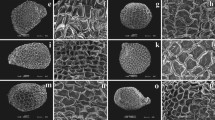Abstract
Seeds of 39 species representing all native genera and sections of New WorldAntirrhineae were examined with the Scanning Electron Microscope and Light Microscope. Based on seed shape and surface ornamentation, seven morphological categories are recognized: cristate, tetracostate, foveolate, tumid tuberculate/cristate, circumalate, medusiform, and a miscellaneous category. Most sections and/or generic categories can be characterized by a single morphological type, althoughMaurandya s.l. has several distinctive seed types included within present generic boundaries. The cristate seed type is believed to be the “primitive type” from which the medusiform and tumid tuberculate/cristate types have developed. The tumid tuberculate/cristate type presumably gave rise to the circumalate, tetracostate, and foveolate patterns. The miscellaneous category (represented byLinaria andKickxia) may be phyletically remote from the other New World types. Seeds of the New WorldAntirrhineae mostly seem to be adapted for water dispersal although some adaptations for wind dispersal (e.g. wings, light weight) are evident. Free-hand sections and seed coat clearings indicate that circumalate seeds are of two different anatomical patterns; such structural diversity may be found in the other seed types.
Similar content being viewed by others
Literature Cited
Arditti, J., Michaud, J. D., Healey, P. L., 1980: Morphometry of Orchid seeds II. Native California and related species ofCalypso, Cephalanthera, Corallorhiza andEpipactis. — Amer. J. Bot.67, 347–360.
Bentham, G., 1846:Scrophulariaceae. — In:DeCandolle, A., (Ed.): Prodromus systematis naturalis regni vegetabilis10, 186–586. — Paris: Victoris Masson.
Campbell, D. H., 1930: The relationships ofPaulownia. — Bull. Torrey Bot. Club57, 47–50.
Canne, J. M., 1979: A light and SEM study of seed morphology inAgalinis (Scrophulariaceae) and its taxonomic significance. — Syst. Bot.4, 281–296.
, 1980: Seed surface features inAureolaria, Brachystigma, Tomanthera, and certain South AmericanAgalinis (Scrophulariaceae). — Syst. Bot.5, 241–252.
Carolin, R. C., 1980: Pattern of seed surface ofGoodenia and related genera. — Austral. J. Bot.28, 123–137.
Chavannes, E., 1833: Monographie desAntirrhinées. — Paris, Lausanne: Treuttel and Wurtz.
Chuang, T. I., Heckard, L. R., 1972: Seed coat morphology inCordylanthus and its taxonomic significance. — Amer. J. Bot.59, 258–265.
Clark, C., Jernstedt, J. A., 1979: Systematic studies ofEschscholzia (Papaveraceae) II. Seed coat microsculpturing. — Syst. Bot.3, 386–402.
Corner, E. J. H., 1976: The Seeds of Dictyledons. — London, New York, Melbourne: Cambridge University Press.
Correll, D. S., Johnston, M. C., 1970: Manual of the Vascular Plants of Texas. — Renner, Texas: Texas Research Foundation.
Crow, G. E., 1979: The systematic significance of seed morphology inSagina under SEM. — Brittonia31, 52–63.
Don, D., 1827: Description of a new genus belonging to the natural family of plants calledScrophulariaceae. — Trans. Linn. Soc. London15, 349–354.
Fahn, A., Werker, E., 1972: Anatomical mechanisms of seed dispersal. — In:Kozlowski, T. T., (Ed.): Seed Biology,1. Importance, Development and Germination, pp. 151–221. — London-New York: Academic Press.
Fuchs, C., 1963: Fuchsin staining with NaOH clearing for lignified elements of whole plants or plant organs. — Stain Technol.39, 141–144.
Gray, A., 1858:Scrophulariaceae. — In:Emory, W. H., (Ed.): Report on the United States and Mexican Boundary Survey,2, 110–121. — Washington: A. O. P. Nicholson.
, 1868: Characteristics of new plants of California and elsewhere, principally of those collected byH. N. Bolander in the state geological survey. — Proc. Amer. Acad. Arts.7, 327–401.
Hill, R. J., 1976: Taxonomic and phylogenetic significance of seed coat microsculpturing inMentzelia. — Brittonia28, 86–112.
Kapil, R. N., Bor, J., Bouman, F., 1980: Seed appendages in Angiosperms. — Bot. Jahrb. Syst.101, 555–573.
Munz, P. A., 1926: TheAntirrhinoideae-Antirrhineae of the New World. — Proc. Calif. Acad. Sci.IV, 15, 323–397.
, 1959: A California Flora. — Berkeley, Los Angeles, London: University of California Press.
Mussellman, L. J., Mann, W. F., 1976: A survey of surface characteristics of seeds ofScrophulariaceae andOrobanchaceae using SEM. — Phytomorphology26, 370–379.
Newell, C. A., Hymowitz, T., 1978: Seed coat variation inGlycine Willd. subgenusGlycine by SEM. — Brittonia30, 76–88.
Pennell, F. W., 1919:Scrophulariaceae of the local flora, II. — Torreya19, 143–152.
- 1935: TheScrophulariaceae of eastern temperate North America. — Acad. Nat. Sci. Philadelphia Monogr.1.
, 1947: Some hitherto undescribedScrophulariaceae of the Pacific states. — Proc. Acad. Nat. Sci. Philadelphia99, 155–199.
Pijl, L. van der, 1972: Principles of Dispersal in Higher Plants. — Berlin, Heidelberg, New York: Springer-Verlag.
Rothmaler, W., 1943: Zur Gliederung derAntirrhineae. — Feddes Repert. Spec. Nov. Regni Veg.52, 16–39.
, 1956: Taxonomische Monographie der GattungAntirrhinum. — Feddes Repert. Beih.136, 1–124.
Seavey, S. R., Magill, R. E., Raven, P. H., 1977: Evolution of seed size, shape, and surface architecture in the tribeEpilobeae. — Ann. Missouri Bot. Gard.64, 18–47.
Straw, R. M., 1966: A redefinition ofPenstemon. — Brittonia18, 80–95.
Sutton, D. A., 1980: A new section ofLinaria. — J. Linn., Soc., Bot.81, 169–184.
Thieret, J. W., 1955: The seeds ofVeronica and allied genera. — Lloydia18, 37–45.
, 1967: Supraspecific classification in theScrophulariaceae; a review. — Sida3, 87–106.
Viano, J., 1979: Investigations au MEB du test des graines du genreLinaria. — Candollea34, 341–355.
Wettstein, R., 1891:Scrophulariaceae. — In:Engler, A., Prantl, K., (Eds.): Die natürlichen PflanzenfamilienIV/3B, 39–107. — Leipzig: Verlag Engelmann.
Whiffin, T., Tomb, A. S., 1972: The systematic significance of seed morphology in the neotropical casular fruitedMelastomataceae. — Amer. J. Bot.59, 411–422.
Yamazaki, T., 1957: Taxonomical and phylogenetic studies ofScrophulariaceae-Veroniceae with special reference toVeronica andVeronicastrum in eastern Asia. — J. Fac. Sci. Univ. Tokyo, Sect. 3, Bot.7, 91–162.
Zuccarini, J. G., 1832: Plantarum novarum vel minus cognitarum, quae in horto botanico herbarioque regio monacensi servantur; fasciculus primus. — Abh. Akad. Wiss. München1, 287–396.
Author information
Authors and Affiliations
Additional information
Contribution No. 82-120j from the Division of Biology and the Kansas Agricultural Experiment Station. This work was supported by NSF Predoctoral Improvement Grant No. DEB 8008151 and by grants from Sigma Xi and the California Native Plant Society, all to the senior author.
Rights and permissions
About this article
Cite this article
Elisens, W.J., Tomb, A.S. Seed morphology in New WorldAntirrhineae (Scrophulariaceae): Systematic and phylogenetic implications. Pl Syst Evol 142, 23–47 (1983). https://doi.org/10.1007/BF00989601
Received:
Issue Date:
DOI: https://doi.org/10.1007/BF00989601




